

Originally posted July 26, 2017
The other day, I sat down to finally get around to doing a Gun of the Week on my old Ruger Super Blackhawk that used to be my grandfather's. As I was getting started on that, though, I realized that the history of the Super Blackhawk is such that it really should be part of a series. At first I thought of stepping back one generation to the rather more famous gun the Blackhawk family is unashamedly based on; but then, as I got to thinking about it, I realized that there was even a step farther back that I could reasonably go.
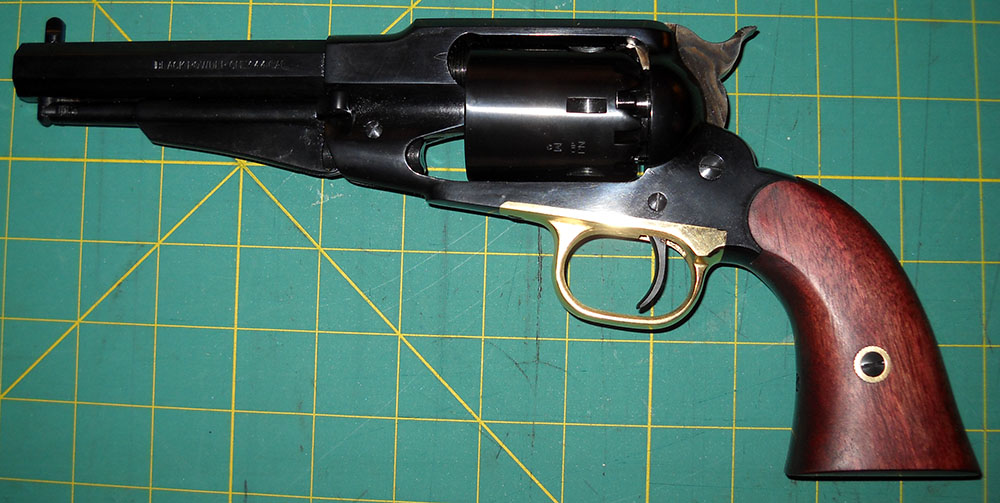
Fortunately, the step before that I've already talked about, in the article from last year about early Colt percussion revolvers. To recap, these were the first commercially viable (barely viable, in the case of some of the early models) repeating pistols, which emerged in the mid-1800s. Colt's signature innovation was what we are now familiar with as the single-action system, whereby cocking the revolver's hammer manually advances the cylinder to the next chamber, then locks it in place, and pulling the trigger drops the hammer on the top chamber's percussion cap and fires the charge.
The key patents on this idea dated to 1836, when Colt's original revolver (retroactively known as the Colt Paterson, because Colt's original factory was in Paterson, New Jersey) first appeared on the market. This meant that by 1856, the basic system was available for anyone else to employ, modify, develop further, and what have you. One of the many people who took advantage of that opportunity was one Fordyce Beals, who patented the design of his improved revolving pistol in 1858. He then sold the rights to produce it to the firm of E. Remington & Sons, a noted manufacturer of both rifles and typewriters based in Ilion, New York.
Remington produced several versions of the revolver, including models in "army" (.44) and "navy" (.36) calibers, directly competing with Colt's revolvers of the same names. The first generation, sold from 1860 to 1862, were sold as the "Remington-Beals"; an improved version without Beals's name appeared in 1862, but was replaced within a year by the third-generation "New Model" series. They were all functionally pretty much the same, in terms of their action and general construction, but embodied progressive refinements in details like the function of the loading lever (remember, this was before metallic cartridges caught on).
The pistol pictured below is a modern replica made by an Italian company called Pietta. Although it's clearly a replica of an 1863 New Model Army, it's sold under the Model 1858 name, because that's what the originals were most commonly called. All three "generations" of the Remington(-Beals) were prominently marked with the original 1858 patent date, which led many people to assume they must all be the "Model 1858", even though the earliest of them were produced in 1860. This particular one, with the 5½-inch barrel, is sold as the "1858 Sheriff", although why sheriffs would have favored shorter barrels than usual (the "default" length at the time was 7½ inches), I couldn't say.
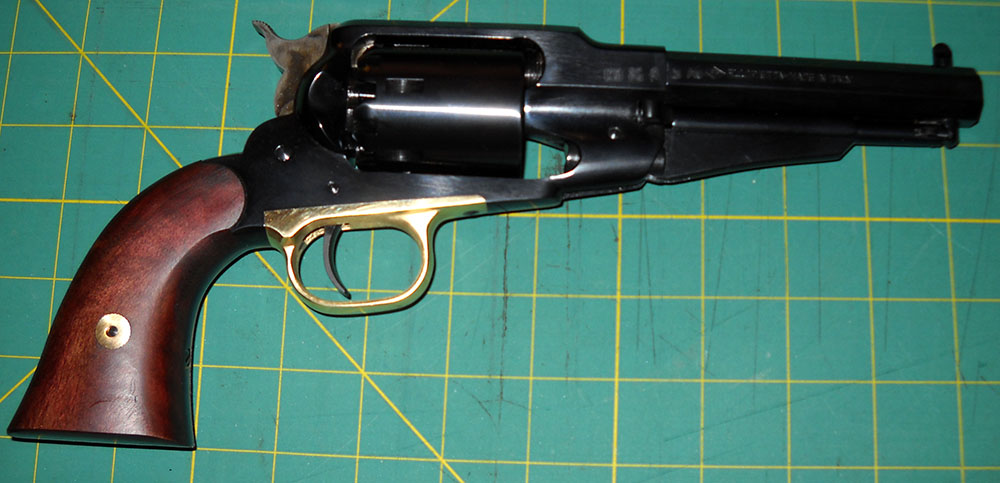
Before we go any farther, let's have a look at some of the New Model Army's features. Like the Colts of the era, it's a single-action, six-shot percussion revolver, and like the Colts (and percussion-fired guns generally), its hammer has a half-cock position, which frees the cylinder to rotate so that the user can cap the percussion nipples.
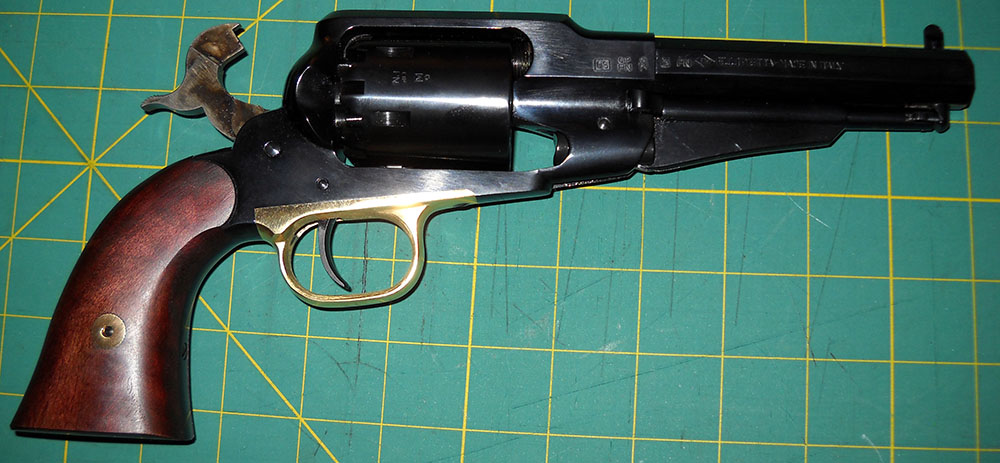
At full cock, the cylinder is indexed to present a chamber to the barrel and locked in place. Pulling the trigger at this stage drops the hammer and fires the top chamber. Note the visible threads on the barrel shank in front of the cylinder. Those threads run all the way through the forward part of the frame there, so the connection is plenty strong, and the last few millimeters of the threaded barrel shank act as the revolver's forcing cone. This was a hallmark feature of the 1858-patent Remingtons.
One of the features that changed during the evolution from the original 1860 Remington-Beals to the 1863 New Model was the loading lever. The original model had a Beals rammer that was covered by a separate patent, but it wasn't very successful, and its replacement was one of the key changes to the 1862 non-Beals-labeled version. According to Markham in Guns of the Wild West, the Beals rammer was replaced with one patented by one William Elliot, but it the Elliot rammer had a design flaw of its own: "This supposedly permitted the cylinder axis-pin to be withdrawn without releasing the rammer catch, but the cylinder catch sometimes slid forward on firing and jammed the mechanism."¹
This flaw led to the replacement rammer being itself replaced in short order, this time by one designed by one of the Remington brothers. The 1863 "New Model" revision introduced a hinged loading/ramming lever very similar to that found on the 1851 and 1860 Colts. This version was designed so that it blocks and helps secure the cylinder pin when latched in the firing position. We'll come back to that cylinder pin in a moment.
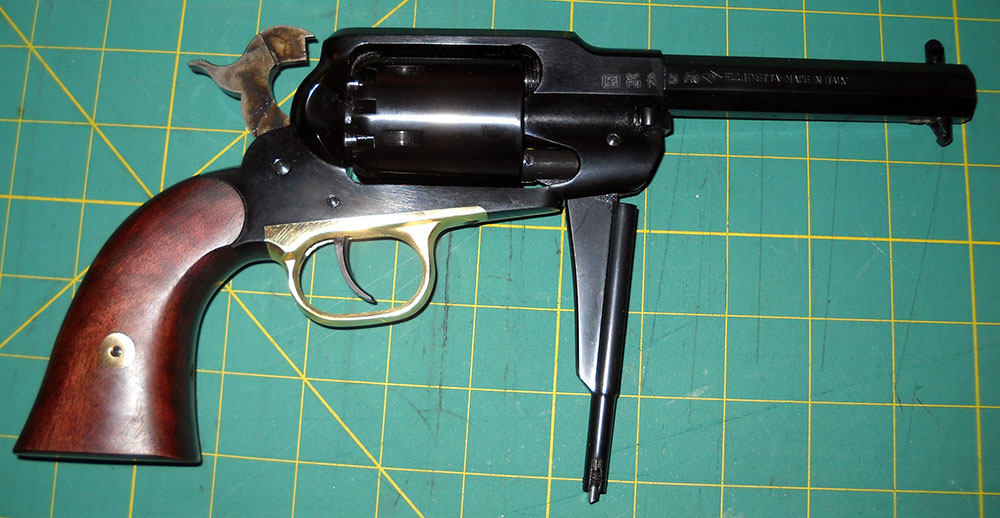
Another feature introduced on the 1863 New Model was a set of slots milled into the back of the cylinder, in between the percussion nipples.
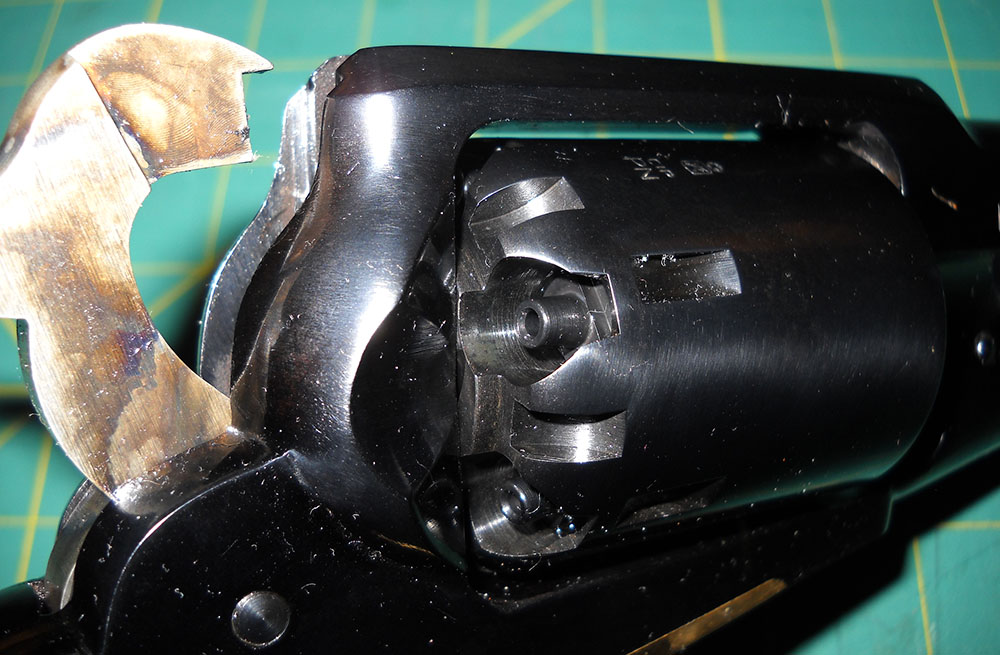
These notches are for the hammer to fit into, the idea being that you could pull the hammer back not quite to half-cock, rotate the cylinder slightly, and then let the hammer back down into one of the slots. This enabled the Remington to be carried safely with all the chambers loaded, which was not possible with many competing products. The cylinder rotation system is designed such that when the hammer is fully cocked, the cylinder indexes to the next chamber regardless of whether it started out with the previous chamber in line with the barrel, or halfway in between on one of the safety notches, so while putting the revolver into the "safe carry" condition required a bit of fiddling, it could be employed instantly and with no special actions.
The Remington New Model Army, introduced in 1863, became the most famous version of the 1858 family, mostly because of its adoption by the Union Army as an issue sidearm at the height of the Civil War. It was significantly more expensive than Colt's 1860 New Army (50¢, a time when a private in the Union Army made $13 a month), but well-liked; and after the Colt factory largely burned down in February of 1864, the Remington became the Union forces' principal sidearm, largely because it was the one that was still available.
The main reason why the soldiers who received the Remington New Model Army preferred it over the Colt New Army was its greater durability. Colt's revolvers, as we may recall, had always had an open frame, with the barrel held on only by a cross wedge through the cylinder axis pin, which is fixed to the frame.
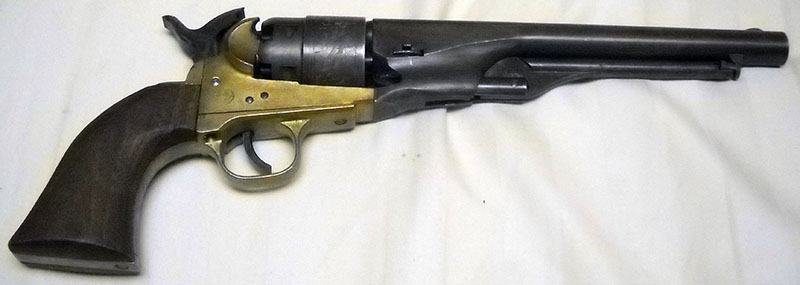
By contrast, the Remington's frame completely encloses the cylinder top and bottom, which makes the pistol structurally much stronger and leaves the cylinder less vulnerable to damage in action. The downside of that—and the reason why Colt preferred an open top—was that the Remington can get jammed if the percussion caps are to come partway off the nipples and get caught between the rotating cylinder and the frame. That can happen with the Colt, too, but on a Colt it has only one chance to happen, whereas on the Remington there are two points of possible interference. Many users seemed to think the increased durability was worth the tradeoff—particularly since the Remington design came with a couple of other handy features the Colt lacked.
For instance, to get the cylinder out of a Colt revolver, the user must dismantle the pistol almost completely: pull out the cross wedge, dismount the whole barrel and loading lever assembly from the frame, and then pull the cylinder off the front. By contrast, the Remington New Model Army has a sliding cylinder pin. This was the Achilles heel of the version with the Elliot rammer, but properly secured by the Remington version, it became one of the pistol's selling points. If you fold the loading lever down out of the way, the cylinder pin slides easily forward...
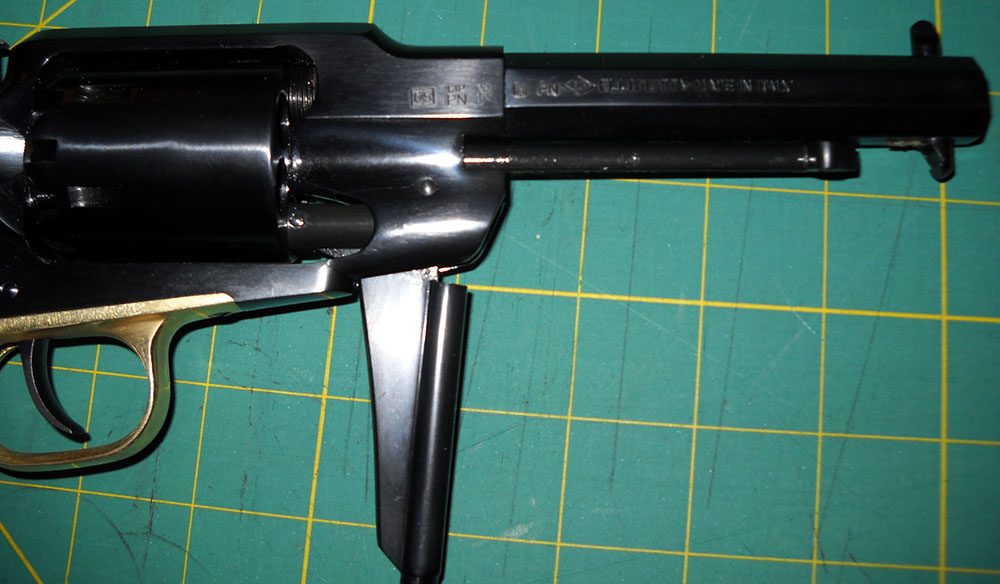
... at which point the whole cylinder drops easily out of the frame.
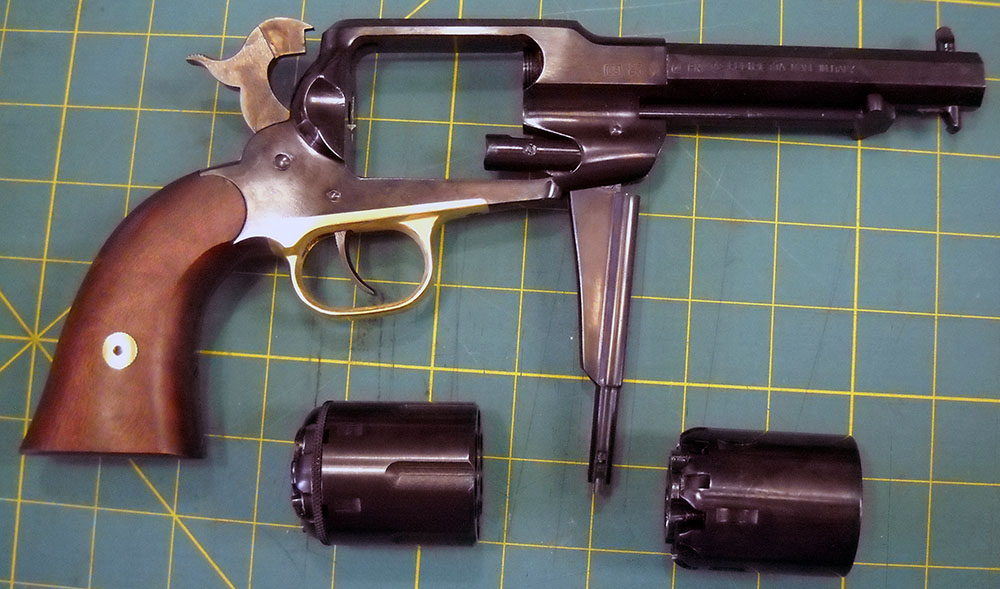
(We'll get into what that other cylinder is for in a bit.)
The important thing here is that only does the cylinder easily drop out, it easily drops back in. This means that a user can theoretically carry several complete, loaded cylinders, at which point reloading the pistol takes a few seconds instead of several minutes.²
In practice, this doesn't seem to have been done very much during the Civil War, as the Army didn't issue extra cylinders, though I wouldn't be surprised if a few of the better-heeled officers ordered a few of their own. At any rate, the New Model Army long outlived the war, and in part, it owed its longevity to the very feature that had made it stand out from Colt's offerings. Its solid frame and easily replaced cylinder made it a natural candidate for cartridge conversion, even before war's end.
This is not to say there were no Colt cartridge conversions, there certainly were. They tended to be a bit cumbersome, though, because of the way Colt revolvers were put together. There was, for instance, no simple way to load or unload a cartridge-converted Colt; you had to take the whole thing apart.
This was complicated further by the various odd gymnastics conversion inventors had to do to get around one of the most ridiculous patents of that or any age. In 1855, an inventor named Rollin White managed to secure a patent (№ 12,648) for a revolver that had, among various other less long-lived features, a cylinder with its chambers bored straight through. Smith & Wesson secured exclusive license to this patent; they weren't interested in White's gun itself, which Markham describes as "complicated and potentially very ineffectual,"³ but in the bored-cylinder idea, having recognized that any revolver attempting to use the newfangled metallic cartridges was pretty much going to have to be built that way.
Today, White would almost certainly not be able to patent the bored-through cylinder concept; it would fail the modern patent law's "cannot be obvious" test. At the time, however, the patent could be interpreted as covering everything that was novel about White's design, and that included the cylinder—and the courts of the time very generally did interpret it that way. This led to three things: a minor extra revenue stream for S&W from people sub-licensing the patent from them; a slew of weird, wacky, not-very-practical attempts at designing cartridge systems that didn't require bored-through chambers; and a different slew of outfits who said the hell with it and infringed the patent.
That third group would have to be taken to court to protect S&W's patent rights; if they didn't take action, they would lose those rights, in the same way in which companies that don't actively protect their trademarks lose them. This would normally have been costly and exasperating. Sometimes patent enforcement battles were so costly and exasperating that they ultimately weren't even worth it. For example, Eli Whitney spent most of the money he made from the cotton gin in ultimately futile court battles with people who ripped off the cotton gin; in fact, he spent most of that money and most of the money he was paid to make rifles for the Continental Army, but that's another story. The point is, it should have cost Smith & Wesson a fortune and years off company officials' lives defending a patent as vigorously infringed upon as White's.
Except they didn't have to, because as if to offset his ridiculous luck in stumbling over one of the most sought-after innovations of the age and managing to be granted a patent on it, Rollin White was evidently the rube of the year. He agreed, as part of the agreement licensing the patent to Smith & Wesson, that he would defend it.
That's right. He licensed his incredibly valuable patent to a large, powerful, successful corporation, and in that license volunteered to shoulder the cost and hassle of the protracted legal battles that would inevitably be necessary to protect their interests.
So that was basically his life for the next 15 years. He ultimately seems to have cleared around $70,000 from his invention (Markham credits him with more than $350,000, but seems not to have taken into account the costs of defending the patent) which was a respectable sum in those days, but by contrast, S&W made something like a million. That doesn't even count the value of the general market dominance they achieved through having a lock on that most useful of features at exactly the time when it was best positioned to meet a rapidly burgeoning demand.4
And so much for Rollin White. The upshot for our story today is that Remington was one of the companies that paid S&W to license the White patent, and so was able to produce in-house cartridge conversions for the New Model revolvers that didn't rely on the various two-piece cylinder replacements, oddball cartridge designs, and other dodges usually found in Colt conversions. They could make a cylinder that the owner could get a gunsmith to drop straight into the gun. With a few modifications to the frame to accommodate loading, and a replacement hammer to hit the new centerfire primers properly, a New Model Remington could be converted to fire cartridges relatively easily and inexpensively. Best of all, converting to fire cartridges eliminated the Remington's biggest weakness in its original percussion form, the percussion caps' tendency to jam in the frame.
Mind you, there was something to be said for not being so hasty to convert to cartridge firing, especially on the postwar western frontier. Carrying a cartridge-firing pistol gave a man a potential logistics problem. You had to be sure you had a reliable supply of ammunition, and although cartridges could be handloaded then just like they can now, things like fresh brass of the correct type and the right size primers could be hard to find out in the sticks.
By contrast, the hardest part of feeding a cap-and-ball revolver was securing a supply of caps, and those were both fairly easy to find and very easy to carry a large supply of, since they were so small. Beyond that, all you needed was gunpowder—obtainable pretty much anywhere—and lead—also very much more common than it is today, since it was used for everything from drain pipes to roofing. Many firearms of the day came with a bullet or ball mold to suit them, and experienced shooters were well-versed in the technique of casting their own projectiles.
Or, with a little ingenuity, you could split the difference and carry a cartridge conversion, then convert it back if you ran out of all-in-one ammo. This was harder to do with the factory Remington conversion thanks to the permanent frame mods and the change to the hammer, but some of the third-party conversion kits of both Remington and Colts made this flexibility a selling point. I have obtained a modern take on one of these conversion kits, which converts my Pietta 1858 into a cartridge-firing revolver. We saw the conversion cylinder in one of the earlier phtoos; let's have a closer look.
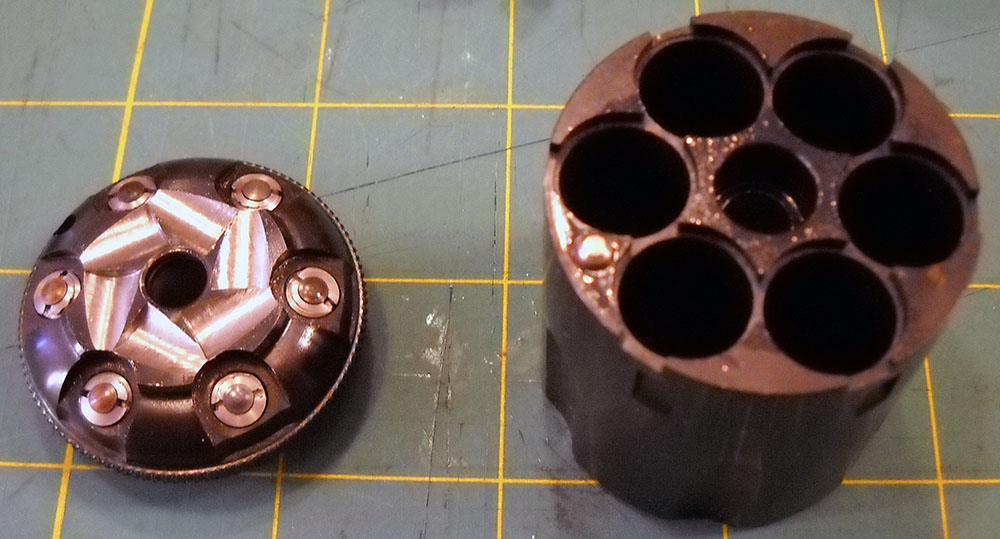
This particular conversion, which is made by Taylor's & Company for the Cowboy Action Shooting crowd, is a two-part system, similar to those used on some Colt conversions back in the day. The main body is a cylinder with rebated chambers for rimmed cartridges (in this case, .45 Long Colt).
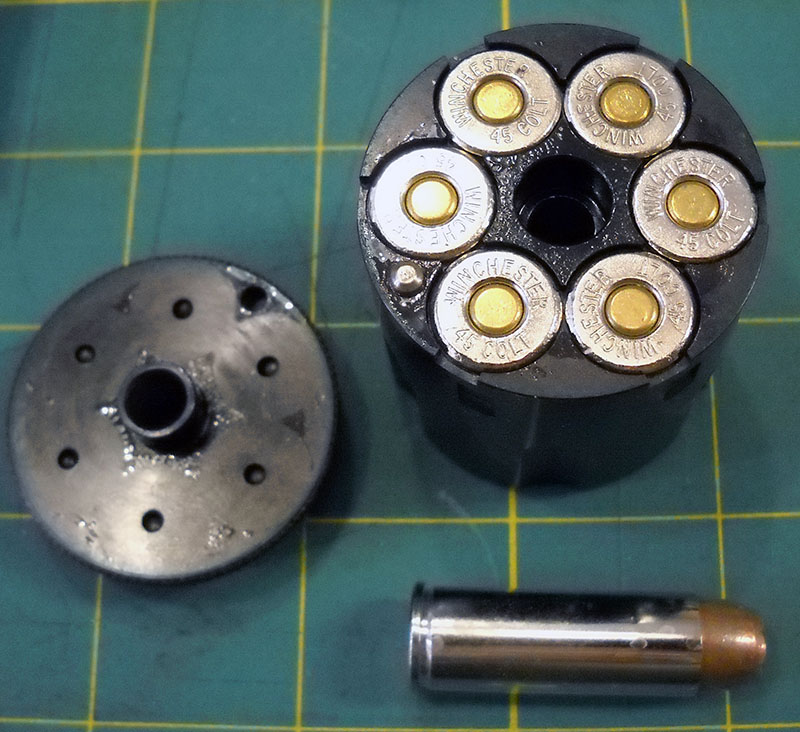
Once the cartridges are loaded, the plate shown to the left fits onto the back of the cylinder and is secured by that silver nub at eight o'clock, which is a little spring detent. Once put together, it's the same size and has the same advancement and firing geometry as the original (shown on the right below), so the gun doesn't know the difference.
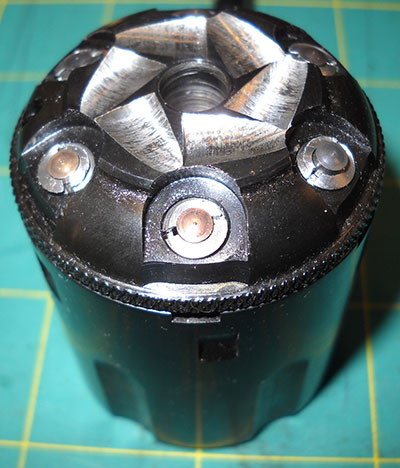
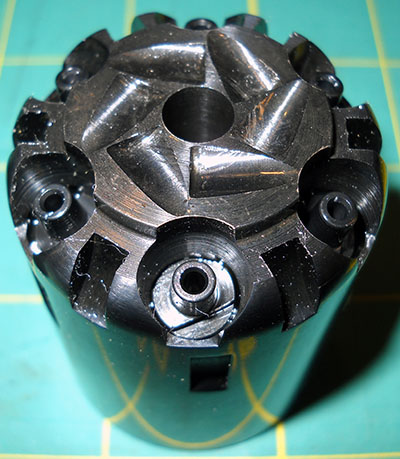
You can see above that each cylinder has its own separate firing pin, which is how this conversion gets around the fact that the original hammer's geometry is designed to hit percussion caps standing proud of the cylinder, not flush-fitted centerfire primers. (Note that the conversion does not have the safety notches, so it's not safe to carry it with all six cylinders loaded. The cylinder's documentation mentions a marking shooters can use to keep track of which chamber is the empty one, but it doesn't seem to have been applied to this particular example.) The modification to the frame needed to allow the Remington factory conversion to be loaded isn't needed either, since the cylinder has to be loaded before it can be assembled in this version. That's less convenient and certainly slower, but it does have the virtue that no permanent modifications have to be made to the gun, so it can be switched back and forth with ease.
With the cartridge cylinder loaded and assembled, it can be slotted into the gun just like the original cylinder, and voilà—one Remington New Model Army (or the modern Italian-made equivalent), converted to use centerfire cartridges in a way that is easily reversed.
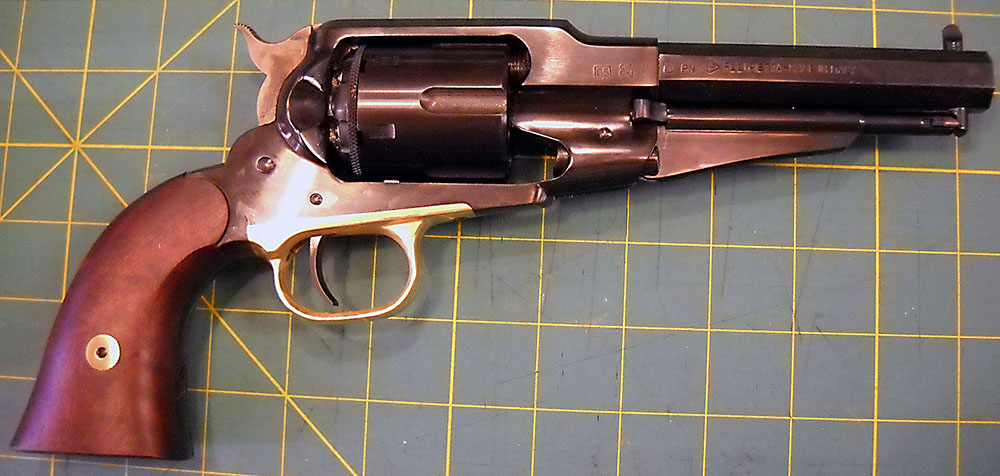
In the interest of full disclosure here, I should note that the actual cartridges shown in the photo above should never be used in this gun; indeed, I put them in the chambers for the photo and then immediately took them out again, without even putting the back plate on, let alone assembling the gun with them in it. Those are modern, smokeless, hot-rod defense loads I bought to use in my Taurus The Judge. Even a new-made Remington 1858 replica should never, ever be used with anything hotter than the low-pressure loads specifically made for cowboy action shooters (which always have "Cowboy" in the brand name somewhere).
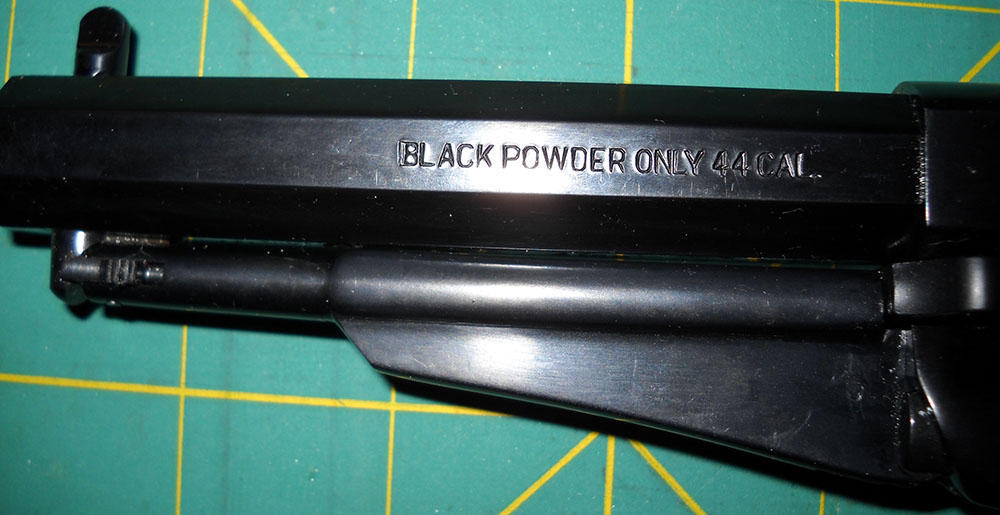
The markings on this new 1858 are pretty unequivocal on that, although obviously they weren't written with cartridge conversion in mind (nor do they reflect that fact that actual black powder is no longer available; what they really mean there is black powder equivalents, like Pyrodex® and the like).
Also, you may note that it's marked .44 (well, actually just "44", but we'll cut them some slack on that) caliber, but the cartridge conversion is for .45 Long Colt. That's normal. .44-caliber black powder revolvers were customarily loaded with either .451 or .454-caliber balls, a bit of which would be swaged off during the loading process; they were still around .45 inch when they were fired into the barrel. This was on purpose, and gave the rifling something substantial to get hold of. Lead is very soft compared with steel, and that extra hundredth-or-so of an inch wouldn't cause any pressure problems. This is another reason why these pistols should only be used with dedicated "cowboy" loads: such loads have soft, unjacketed lead bullets, not the harder jacketed projectiles modern cartridges tend to have.
(As an aside, that nominal diameter of .454 inch lives on today in the "magnum" version of the .45 Long Colt cartridge, .454 Casull.)
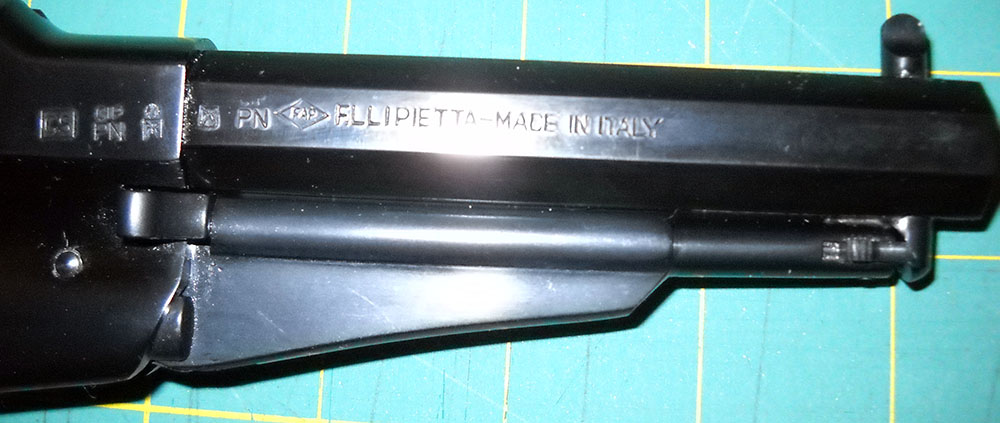
Meanwhile, over on the right-hand side, we have a salad of Italian proof marks and the name of the company. "F.LLI" is a contraction of "FRATELLI", meaning the company's name translates to "Pietta Brothers". Note that this one was clearly made for the US import market, since the origin marking is written in English. A great many of the modern reproductions of black powder firearms are made in Italy nowadays. Offhand, I can think of Pietta, A. Uberti (part of the Beretta Group), and Davide Pedersoli & C., which is also headquarted in Beretta's old hometown of Gardone Val Trompia. Pedersoli makes some really nice-looking high-end stuff, including a replica of the Remington 1863 "Zouave" rifle that I would very much like to have one of someday.
Anyway, that's the Remington 1858 family. The Remington company continued developing revolvers through the rest of the 19th century, but after 1873 were largely overshadowed by Colt (and we'll get into that next time), whose offerings their own later models tended to be more and more like. In 1918 they tried to step into the automatic market with the ill-fated Model 51, after which they kept to long arms until fairly recently.
Nowadays, of course, they make a 1911 clone like everybody else, as well as a couple of more modern semiauto designs (including the equally-ill-fated R51), but nothing that has the kind of presence, market share, or following that their 1858-pattern revolvers had in their day. Though often overlooked by non-enthusiasts today because of the massive name recognition of the Colt legacy, Remington revolvers had just as big a part in "winning the West", and there's a certain clade of older Western films that made a point of that. In some old Westerns, a man who carried a Remington was a little bit different from the others.
--G.
¹ George Markham, Guns of the Wild West: Firearms of the American Frontier 1849-1917 (London: Arms & Armour Press, 1991), 39.
² Although you wouldn't want to carry around a loaded and capped cylinder outside the gun, so you would need to take a few moments to cap the new cylinder once you'd installed it. It would still be orders of magnitude faster than loading powder, ball, and grease into all six chambers with the cylinder mounted.
³ Markham 1991, 50.
4 There is a sad postscript to the Rollin White story. In 1870, having spent 15 years of his life defending a patent that was profiting others much more than himself, he applied to Congress for an extension to his patent, which had expired the previous year. The bill passed Congress easily, but President Ulysses S. Grant—remembering that White's vigorous defense of his patent during the Civil War had inconvenienced, embarrassed, and/or driven out of business a number of Union Army firearms contractors and thus, in his view, hindered the war effort—vetoed the shit out of it. White got nothing, his patent duly expired, and after five further years of trying to get it retroactively reinstated, he gave up and disappeared into obscurity.
Markham claims that White went on to found the White Motor Company, which produced one of the early 20th century's reasonably successful steam-powered automobiles and later went on to be a well-known brand of semi trucks, but the timing doesn't work; the Rollin White who developed the White steam car patented it in 1900, by which time the Rollin White who had the 1855 pistol patent had been dead for eight years. It is an uncommon name, though, so perhaps the younger was the elder's descendant. (Possibly a grandson; Rollin White the younger's father's name was Thomas, but I haven't found any mention of Rollin White the elder having a son by that name, or indeed any children at all.)